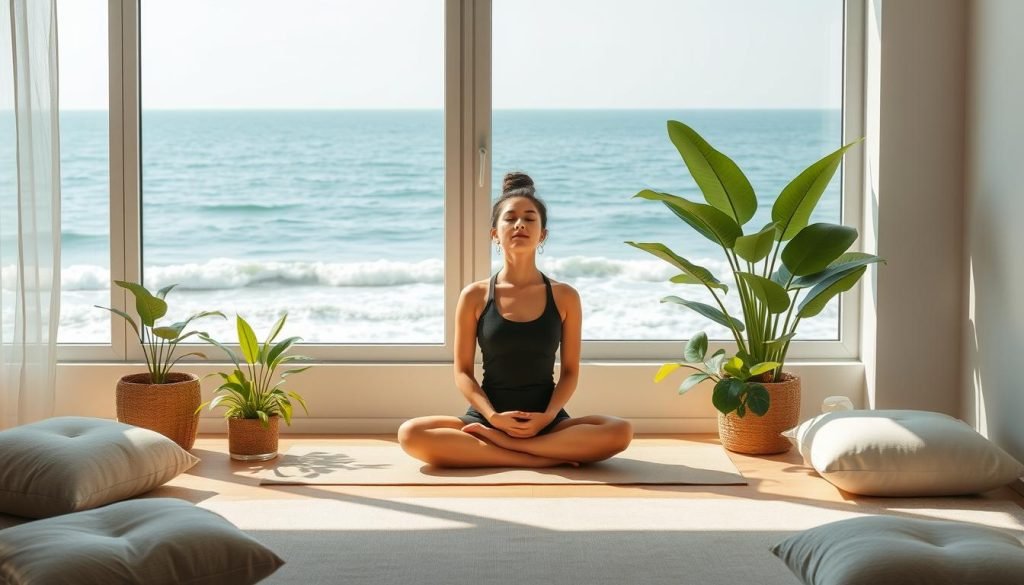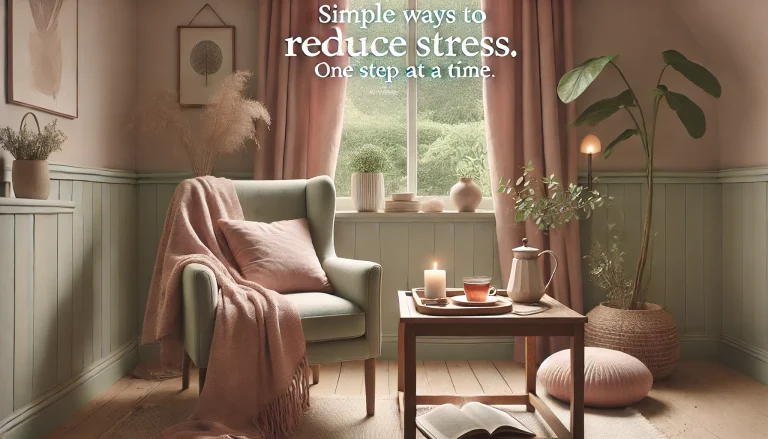Soothing Stress: Breathing Exercises for Relief
In today’s fast world, stress can feel too much. Finding ways to ease it is key. I’ve found that simple breathing exercises for stress can really help. They’re easy to do and can calm your mind right away.
These exercises don’t just offer quick relief. Doing them regularly can make a big difference over time. It can even improve your overall health and happiness.
When I’m feeling anxious or stressed, deep breathing makes a huge difference. Just 3 to 5 minutes a day can calm my heart rate and lower my blood pressure. It also helps me sleep better. These breathing exercises for anxiety are more than a quick fix. They’re essential for managing stress every day.
Understanding the Impact of Stress on the Body
Stress affects my mental health and physical health in many ways. When I’m stressed, my body releases hormones like cortisol and adrenaline. This can make my heart beat faster, my breathing shallower, and my muscles tighter.
In the short term, these signs can be handled. But long-term stress can lead to serious health problems. These include headaches, high blood pressure, and even heart disease. It’s crucial to manage stress well.
Our brains link emotions with breathing patterns. Changing how I breathe can change how I feel. For instance, breathing in for four counts and out for eight can calm me down.
Doing breathing exercises regularly trains my nervous system. Over time, I react less to stress. This makes managing stress easier.

Benefits of Breathing Exercises for Stress Relief
Breathing exercises are a great way to reduce stress. They help us relax and feel calm. By controlling our breath, we can move from anxiety to peace.
Natural Calming Mechanism
When we focus on our breath, we connect with our body’s calming system. This system lowers our heart rate and blood pressure. Studies show that breathing exercises can lower anxiety levels.
These exercises don’t just calm us down. They also improve our emotional health.
Improved Focus and Clarity
Adding breathing exercises to our daily routine boosts concentration. It helps us stay focused and clear-minded. This makes tackling daily tasks easier.
Research shows that regular breathing exercises improve mood and reduce anxiety. This leads to clearer thoughts and actions.

Breathing Techniques to Alleviate Stress
Stress can be a big problem in our daily lives. It can lead to health issues if not handled right. I’ve found many breathing techniques that help control breath. These methods can reduce stress and make us feel better.
Knowing the different techniques helps me pick the right one for me.
Overview of Various Techniques
Some breathing techniques are simple yet very effective:
- Diaphragmatic Breathing: This method uses the diaphragm for deep breathing. It improves oxygen flow and calms the nervous system.
- Box Breathing: I inhale for four counts, hold for four, exhale for four, and pause for four. It helps ease anxiety and promotes relaxation.
- Take 5 Method: Great for those with breathing issues, it slows down breathing by focusing on senses. It’s helpful in stressful moments.
- 1:2 Breathing: Inhaling for three seconds and exhaling for six creates a balanced breathing pattern. It’s good for managing stress.
- Alternate Nostril Breathing: This technique involves inhaling through one nostril, pausing, exhaling through the other, and pausing again. It balances energy and calms the mind.

I also start with simple exercises like taking five deep breaths. These deep breathing techniques help relax and focus. They’re especially helpful during busy times.
Breathing Exercises for Stress: A Step-by-Step Guide
Adding breathing exercises to your daily routine can really help with stress. It’s easy to start a simple routine that relaxes you and boosts focus. Here are some effective techniques I’ve found helpful, along with the best times to use them.
How to Practice
Beginners should start with five deep breaths. This basic step is the foundation for more advanced methods. Here are some techniques I recommend:
- Counting Breaths: Breathe in while counting to 1, then breathe out and count to 2. Adjust the counts as needed; try inhaling for 3 seconds and exhaling for 6 if the counts feel too short.
- Belly Breathing: Focus on breathing into your belly, letting it rise and fall. This can help ease anxiety.
- Box Breathing: Breathe in for 4 counts, hold for 4, breathe out for 4, and hold again for 4. This method improves focus and clarity.
- Alternate Nostril Breathing: Also known as Nadi Shodhana, this balances the brain and brings peace.
- Diaphragmatic Breathing: Breathe deeply into your abdomen for 5 to 10 minutes, increasing time and intensity. This boosts lung function and aids in relaxation.
When to Incorporate These Exercises
When you do these exercises matters a lot. Use them during these times:
- During work breaks to recharge and refocus.
- Before bed to relax and sleep better.
- When feeling overwhelmed to calm down and clear your mind.
Being consistent is key. Regular practice strengthens the calming effects of these exercises. It improves your stress management over time. For help, I often use the Headspace app. It has animations and easy instructions to guide you.

The Science Behind Breathing Exercises
The science of breathing techniques shows a cool link between our breath and health. Doing breathing exercises can make us feel better by lowering stress. When I breathe deeply, I feel relaxed, and it helps lower my blood pressure and heart rate.
Studies say slow breathing calms our nervous system. This makes us less stressed. It also boosts our immune system by getting rid of germs and viruses.
Using techniques like Pursed Lip Breathing or Diaphragmatic Breathing helps a lot. These methods make sure our muscles get enough oxygen and nutrients. I’ve found these exercises simple to add to my day, making them easy for anyone to do.
To get the most from breathing exercises, do them for a few minutes at a time. Keeping the air clean and standing right also helps. Using air purifiers and staying away from bad places makes it easier to relax.

Deep Breathing Exercises for Effective Stress Management
Deep breathing exercises are a great way to manage stress. They help both your body and mind. By using your diaphragm, you take in more oxygen, which relaxes you.
Regular deep breathing helps me deal with daily stress. It also helps fight stress right away.
How Deep Breathing Works
Deep breathing can stop stress in its tracks. It starts a relaxation response in your body. This lowers cortisol levels and reduces anxiety.
It also improves focus and clears your mind. Deep breathing reduces physical tension. This helps with headaches and muscle tightness.
It also boosts sleep and immune function. This makes you stronger against stress-related illnesses.
Tips for Practicing Deep Breathing
Here are some tips for deep breathing exercises:
- Find a comfortable position, whether sitting or lying down.
- Maintain a slow rhythm, allowing your breath to flow naturally.
- Consider using visualization techniques to enhance your relaxation experience.
- Practice using structured methods, such as the 4-7-8 technique or equal breathing.
- Be aware of signs such as irritability or difficulty sleeping to know when to start.
For daily stress relief, practice these exercises three to four times a day. Morning sessions are especially refreshing, setting a positive tone for the day.

Progressive Muscle Relaxation and Breathing
Progressive muscle relaxation (PMR) is a powerful technique that I use to connect my breath with the physical sensations of tension and relaxation. It starts with deep breathing, which calms the body and mind. With each breath, I focus on giving my body more oxygen, promoting relaxation.
To practice PMR effectively, I start by finding a comfortable sitting position. I keep my back straight and ensure I won’t doze off during the process. I take a few moments to breathe deeply, counting to three while inhaling and four while exhaling. This establishes a soothing rhythm for my breathing techniques for tension.
The first step involves tensing and relaxing different muscle groups, starting with my hands and forearms. I tightly clench the muscles for a count of five, then slowly release. I move through my upper arms, feet, shins, calves, knees, thighs, buttocks, abdomen, and lower back. Doing each exercise about six times helps me feel the difference between tension and relaxation.
Listening to my body is crucial during this practice. If I experience any pain or discomfort, I stop that exercise. The goal is to focus on achieving relaxation, not tightness. By combining diaphragmatic breathing with progressive muscle relaxation daily, I manage stress better.
Setting aside five to ten minutes twice a day for this practice improves my anxiety management. It also supports better sleep quality and reduces chronic pain. PMR and the associated breathing techniques for tension have no adverse side effects or interactions. They are a gentle yet effective way to relieve stress.
Guided Meditation for Stress Relief
Adding guided meditation to my daily routine has changed how I handle stress. I’ve found that mixing guided sessions with breathwork makes me feel more relaxed. This combo helps me notice my breathing better, which is key in dealing with anxiety and tension.
Combining Meditation with Breathwork
Guided meditation often uses meditation techniques that focus on breathing. I start with a deep breath: inhale for three, hold for two, and exhale for four. This helps me focus and get ready for meditation. During meditation, I pay attention to my breath in my body, feeling it in my abdomen, chest, and throat.
If my mind drifts, I bring it back to my breath. This keeps me focused and helps me relax.
Popular Guided Meditation Techniques
There are many effective techniques I’ve tried:
- Body Scan Meditation
- Visualization Exercises
- Breath Awareness Sessions
These methods all use breathing to calm us down. I practice mindfulness for under 15 minutes a day, keeping it up for a week. Regular practice makes me more mindful, even when things get tough. These techniques not only ease stress but also lower anxiety and help us relax.
Mindful Breathing Techniques for Everyday Life
Adding mindful breathing to my daily routine has changed my life for the better. It helps me stay in the present, reducing stress and improving my focus. Through mindful breathing, I become more aware of my surroundings and feelings, making it easier to handle anxiety.
Incorporating Mindfulness into Breathing
Using mindful breathing techniques has made my daily life better. Here are some ways I bring mindfulness into my breathing:
- Check In: I often stop to check my breathing and listen to my body.
- Focus on Sensations: I focus on the feelings in my chest, belly, and nostrils with each breath, staying present.
- Set Intentions: I start my day with a plan to be mindful, guiding my actions.
- Mindful Moments: I take a few deep breaths while commuting or on breaks, instantly reducing stress.
- Gratitude Breaths: I spend a few breaths feeling thankful, boosting my mood.
By adding these mindfulness practices to my routine, I’ve found it easier to manage stress. Taking a few minutes each day for mindful breathing helps me tackle challenges calmly and clearly.
Breathwork for Stress Management
Breathwork is key for managing stress. It includes many breathing techniques that help relax and balance emotions. These practices have been around for ages and are now popular in wellness.
Understanding Breathwork
Many breathe shallowly, which can make them feel anxious and tired. Breathwork can change this. By learning different breathing methods, you can better handle stress.
Practicing breathing exercises for 10 minutes can really help. Longer sessions, up to 20 minutes, offer even more benefits. Techniques like progressive muscle relaxation and the lion’s breath offer unique benefits.
Deep breathing regularly, once or twice a day, can reduce anxiety. Diaphragmatic breathing, done for 5 to 10 minutes, boosts both emotional and physical health. Starting with short sessions and increasing to 20 minutes can help you feel calmer.
Exercises like alternate nostril breathing can also help you relax. Equal breathing for at least five minutes can improve your mental health. Learning and practicing these techniques can empower you to manage stress better.
Relaxation Breathing Exercises to Try
Adding relaxation breathing exercises to my daily routine has greatly reduced my stress. These stress relief techniques are easy to do and fit well into my busy life. Here are some exercises that have really helped:
- 4-7-8 Breathing Technique: Dr. Andrew Weil made this method famous. You breathe in for four counts, hold for seven, and breathe out for eight. It’s great for relaxing, especially before bed.
- Box Breathing: This technique is used by military and first responders to calm their nerves. It’s quick and effective. Breathe in for four counts, hold for four, breathe out for four, and hold again for four. Do this for five minutes.
- Deep Belly Breathing: This exercise makes you breathe deeply into your belly. Inhale slowly through your nose, letting your belly rise. Then, exhale through your mouth. Just 10 to 20 minutes can deeply relax you.
- Progressive Muscle Relaxation: This isn’t just breathing, but it works well with it. Tense and then relax each muscle group. It helps release physical tension while focusing on your breath.
- Balanced Breathing: Also known as coherent breathing, this involves slow, long breaths at five breaths per minute. Doing this three times a day balances your nervous system and boosts relaxation.
Try these relaxation breathing exercises once or twice a day for the best results. Each exercise can take a few minutes or up to 10 minutes. This lets you adjust your de-stressing routine to fit your schedule. Remember, with 20,000 breaths a day, breath is a powerful tool for calming.
Alternate Nostril Breathing: A Unique Technique
Alternate nostril breathing is a fascinating way to lower stress. It involves breathing through each nostril, balancing your body’s energy. This method calms the mind, improves focus, and brings relaxation.
Studies show its benefits. A 2020 study found better pulse and blood pressure in those who practiced it. A 2018 study showed lower stress in men who did it daily. These findings make it a valuable stress relief method.
- Begin by sitting comfortably with your spine straight.
- Use your thumb to close your right nostril.
- Inhale deeply through your left nostril.
- Close the left nostril with your ring finger, release the thumb, and exhale through the right nostril.
- Inhale through the right nostril, close it, and exhale through the left nostril.
Doing this for 10 minutes can greatly benefit you. It increases breath awareness and positively affects your nervous system. However, those with asthma or COPD should talk to a doctor first.
Alternate nostril breathing fits well into yoga or meditation. I suggest trying it to see how it can help with stress.
Additional Stress Relief Techniques Complementing Breathing Exercises
Breathing exercises are great for stress relief, but adding more techniques can make them even better. Yoga, tai chi, and mindfulness are excellent additions. They help with both mental and physical health. These practices work together to reduce stress and improve overall health.
Yoga is a strong ally in managing stress. It helps lower heart rates and blood pressure. When paired with breathing exercises, it brings a deeper sense of peace and awareness. Tai chi, with its gentle movements, improves focus and balance, helping with emotional control.
Mindfulness meditation is another key practice I’ve added. It has helped 35% more people find comfort. Visualization and progressive muscle relaxation also lower anxiety and boost relaxation. Together with deep breathing, these techniques help me stay grounded and handle life’s challenges.




